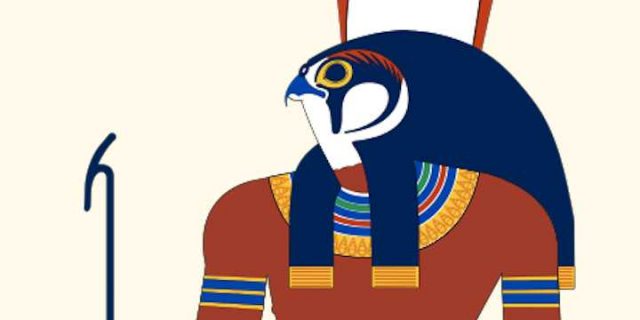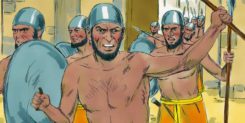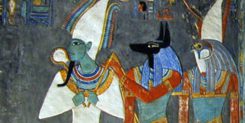Egyptian god Horus (Wikipedia)
What if the story of Jesus was a legend, copied from the legends of the Egyptian god Horus? That would prove christianity was false, surely?
And that is what is claimed. Something like 200 parallels between the two religious figures. 16 main claims. Enough to show that Jesus was an invention, it is said.
On this page I give a quick outline of Egyptian religious belief, and the various beliefs about Horus. Then I check the claims against what historians tell us about Horus, and Jesus. Is there evidence that the supposed parallels are real?
On this page
Ancient Egyptian religion
The ancient Egyptians had a complex polytheistic religion where numerous gods and goddesses represented various natural forces. Some gods were associated with particular regions. People could appease the gods through various offerings and rituals. The Pharaoh was the intermediary who controlled the temples. Sometimes he was even considered to be the god himself.
Myths developed which explained the gods’ characteristics and behaviour. Beliefs and even names changed over time.
The afterlife was an important part of Egyptian religion. Initially the Egyptians believed only the Pharaoh could go on to a happy afterlife. But later the nobles, and eventually everyone, could aspire to an afterlife in paradise if their life was judged worthy. They had complex beliefs about the relationship between body and life-force, which led to the funerary practices of mummification and the construction of burial places that would preserve the body.
Horus, a god worshipped for 3 millennia
Horus was an Egyptian god first worshipped in Upper Egypt more than 3,000 years BCE. Over three millennia, Horus worship, and the stories and beliefs about him, changed and developed, so that he (or gods very like him) appear under different names. So the role he played in Egyptian mythology varied.
For example, in early Egypt, Horus was the brother of Isis, Osiris, Set and Nephthys. But later he became the son of Isis and Osiris (who were brother and sister). For a significant period, Egyptians saw the Pharaoh as the embodiment of Horus. When the Pharaoh died he was identified with Osiris in the afterlife, and the new king embodied Horus.
The role of Horus
Horus is one of the oldest of the Egyptian gods. In the beginning he was the god of light in the upper kingdom, but when the two kingdoms were united, he became the national god. Horus was the sky god, and so contained the sun and moon, which were his eyes. Hence Horus was sometimes symbolised by an eye, but was mostly depicted as a falcon or a falcon-headed man. He was also the god of war and hunting.
Horus, as god of the fertile kingdom, especially the upper kingdom, was in conflict with Set, the god of the desert and the lower kingdom. This explained or symbolised the victory of the upper kingdom over the lower, or of the fertile kingdom over the desert.
Information about Horus comes from:
- recent archaeological finds which linguists can now translate using the Rosetta Stone, which was discovered two centuries ago, and
- various funery texts sometimes named The Egyptian Book of the Dead.
Horus and Jesus
The supposed similarities between Jesus and Horus were first raised by Gerald Massey (1828-1907), an English poet and writer on Spiritualism and Ancient Egypt. Massey was self taught, but had access to records in the British Museum, and taught himself to read Egyptian hieroglyphics.
Massey saw parallels between Jesus and not only Horus, but hundreds of other Egyptian gods. But it is the supposed Jesus-Horus parallels that have made most impact. His views were taken up by other writers, notably Tom Harpur and Acharya S, who have written on this topic in recent decades. These claims also appeared in the films Zeitgeist (2007) and Religulous (2008).
A table showing the main claims is below. As far as I can ascertain, none of these claims have been made by recognised scholars.
The response by Egyptologists and historians
Recognised scholars have not given much credence to the claims, for the following reasons:
- The Jewish people were fiercely monotheistic, and resisted the influence of foreign religions. Most scholars today believe that the pagan religions exerted little or no influence on first century Jewish thinking. Jewish history and the Jewish scriptures (our Old Testament) provide the best basis for understanding Jesus.
- Much of the information about Horus only became known via modern archaeology, and could not have been known by the early christians.
- Most of the claimed parallels are either contrived (sometimes called parallelomania = exaggerating the importance of trifling resemblances) or completely spurious.
- Horus was a mythological figure but the main facts about Jesus (including many of the claimed parallels) have a sound historical basis.
For a summary of the scholars’ views on the influence of all pagan religions on early christianity, see Was Jesus a copy of pagan gods?
The alleged similarities
Massey apparently claimed 200 parallels, though many of these are multiple aspects of the same events, so there was a smaller number of events for us to consider.
I have been unable to find a definitive response by a recognised egyptologist or historian. I have therefore checked the mythologies outlined on Egyptian mythology sites plus sites which assess each claim.
The table below shows what seem to be the main claims about Horus, together with the most reliable responses I can find.
| Claimed parallel | Assessment |
|---|---|
| He was born of a virgin (Meri) whose husband was Seb (=Jo-seph). | His mother Isis is referred to in one inscription using a word that can mean virgin or young woman, but the main stories say Horus was conceived by her having sex with Osiris (after Isis had raised him from death). Seb was not Horus’ father but Osiris’ father, and there is no connection between the two names except the letters “se”. Meri was a word meaning “beloved”, not a name. |
| He was born in a cave on December 25, heralded by angels and visited by shepherds. | None of these details are recorded. Horus was born in a swamp. His birth is generally said to be in November. |
| His birth was announced by a star in the east and he had 3 heavenly visitors (like the 3 Magi). | I can find nothing definitive on 3 deities visiting Horus’ birth. It appears both these claims have arisen because Massey made some connection between the constellation Orion (which has three distinctive stars making up Orion’s belt), |
| Herut (= Herod) tried to have him murdered after his birth. | It has been said that Herrut was an evil serpent who later became the god Set, but sources I could find only say Herut was another name for Horus. |
| He came of age at 12, but then nothing is heard from him until he was 30. | The age of 12 has no significane in the Horus stories, and there is no continuous narrative to allow identification of gaps. |
| He was baptised by Anup the Baptiser who was later beheaded. | There is no Anup the Baptiser in Egyptian mythology and certainly none in the Horus story (he was apparently invented by Gerald Massey). |
| He was tempted in the desert. | Horus was often in combat with the desert god Set, but there is no mention of temptation. |
| He came to fulfil the law. | There was no Egyptian Law to fulfil. |
| He had 12 disciples. | Different stories mention different number of followers – 4 or 16, but never 12. |
| He performed miracles, exorcised demons, stilled the sea and walked on water. | Horus is recorded as performing miracles, but not exorcisms or walking on water. There is a picture of him standing on crocodiles, which may be the origin of this claim. |
| He raised Osiris (also known as El Osiris and Asar = Lazarus) from the dead. | In the main version of the Horus, story, Osiris is raised, not by Horus but by Isis, so Horus could be conceived. There is no record of Osiris being called El Osiris. |
| He preached a sermon on a mountain and was transfigured there | There is no record of either of these. |
| He died by crucifixion with 2 thieves | In some versions of the myth, Horus died and was thrown into the sea, but in most versions he never died. Horus was eventually merged with Ra, and Ra died every day (see below). Crucifixion wasn’t used as a punishment until 600 BCE, so it couldn’t appear in the Horus myth – the only basis for this claim seems to be a picture of Horus standing with arms outstretched, but there is no mention of crucifixion. |
| He was resurrected after 3 days and women were witnesses | In some later mythology, Horus was absorbed into Ra, the sun god, and Ra was considered to die each night at sunset and rise again each dawn, like other sun gods. But Horus himself was never resurrected. The closest to this is a time when Horus was bitten by a poisonous scorpion and most translations say he nearly died before the god Thoth healed him, but one translation suggests he died and was restored. |
| He was called Iusa (close to Jesus), Messiah and many other names also given to Jesus | Iusa never existed as a name, and so was given to no-one, including Horus. Horus was given several titles, but none of the are the same as any titles given to Jesus – the closest is “Great God”. |
| He was supposed to reign for 1000 years | This isn’t mentioned in Egyptian mythology |
Summary
The claimed parallels can be grouped into four categories:
1. A small number that are correct but unremarkable
Both were considered as divine, although scholars have still not agreed on when Jesus was first regarded as divine. But the earliest stories of Jesus only contain cryptic claims to divinity, and emphasise his humanity, quite the opposite of Horus. Both performed some miracles.
The same would have been true of many ancient figures, and so they can hardly be considered something the early christians copied from Horus.
2. A small number where there is some superficial resemblance
For example, both had some sort of confrontation related to the desert, but the similarities are minor. Horus is pictured in one place standing on crocodiles, which has been construed as walking on water.
With a pantheon of hundreds or thousands of gods, and many versions of some myths, it is hardly surprising that some superficial resemblances occur. Probably similar parallels could be seen with other ancient mythical or historical figures.
3. Misrepresentations
Many of the claimed parallels seem to have come from some myth not related to Horus.
4. Inventions
Many of the stories no basis in Egyptian mythology and seem to have been totally invented. It appears that modern writers have simply followed Gerald Massey without checking the stories. Occasionally they seem to have invented new parallels.
Conclusion
The whole Horus-Jesus parallel has virtually no basis in fact. It is surprising it has been accepted by many. Historian “Paula Fredriksen states that no serious scholarly work places Jesus outside the backdrop of 1st century Palestinian Judaism”
(Wikipedia).
Feedback on this page
Comment on this topic or leave a note on the Guest book to let me know you’ve visited.
References
Pages on Jesus and pagan religions on this site
References on Ancient Egypt
- Wikipedia on Prehistoric Egypt,
Ancient Egyptian Religion and
Book of the Dead. - Encyclopedia Mythica
- Sites maintained by non professionals which neverthless contain much useful information:
Ancient Egypt: the mythology and
Ancient Egypt Online.
References on Jesus and Horus
- Wikipedia on Horus,
Jesus Christ in comparative mythology and
a discussion on why certain claims about Horus were removed from Wikipedia. - I was unable to find any site which supports the claims about Horus and Jesus and offers references. These are typical of the many sites out there which simply repeat the claims:
Religious Tolerance (unfortunately this site is very unreliable, generally only referencing a few authors with no established expertise in the subject),
Skeptics Stack Exchange and
a letter sent to Religious Tolerance pointing out errors on their page. - Sites which provide information on Horus, against which the claims can be assessed:
Encyclopedia Mythica,
Ancient Egypt Online,
Ancient Egypt: the mythology and
Ancient Egypt. - Sites which assess the claims:
King David 8.com (based on the Book of the Dead and online mythology sites),
Skeptic Project, (contains many references to expert websites and books)
The Divine Evidence (lists many sources from ancient Egyptian texts),
Stupid Evil Bastard (based on the Book of the Dead),
Cold Case Christianity,
The Straight Dope (no references are given), and
Jon Sorenson (only a few references are given).







